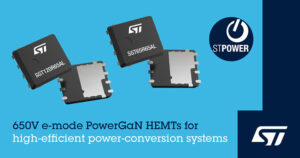STMicroelectronics has begun volume production of electronic mode PowerGaN HEMT (high electron mobility transistor) devices that simplify the design of high-efficiency power conversion systems. STPOWER GaN transistors increase performance in applications such as wall adapters, chargers, lighting systems, industrial power supplies, renewable energy applications and in automotive electrification.
 The first two products in the family, the SGT120R65AL and SGT65R65AL, are industrially qualified 650V normally-off G-HEMT in a PowerFLAT 5×6 HV surface mount package. They have current ratings of 15A and 25A respectively, with typical bonding resistance (RDS(on)) of 75mΩ and 49mΩ at 25°C.
The first two products in the family, the SGT120R65AL and SGT65R65AL, are industrially qualified 650V normally-off G-HEMT in a PowerFLAT 5×6 HV surface mount package. They have current ratings of 15A and 25A respectively, with typical bonding resistance (RDS(on)) of 75mΩ and 49mΩ at 25°C.
Furthermore, the total port charge of 3nC and 5.4nC and low parasitic capacitances ensure minimal power losses when switching on/off. A Kelvin source connection allows optimized gate drive. In addition to the reduced size and weight of the power supplies and adapters, the two new GaN transistors provide greater efficiency, lower operating temperatures and longer service life.
In the coming months, ST will introduce new PowerGaN variants, i.e. automotive-qualified devices, as well as additional power pack options including PowerFLAT 8x8 DSC and LFPAK 12x12 for high-power applications.
ST's G-HEMT devices facilitate the transition to wide-bandgap GaN technology for power conversion. GaN transistors with the same breakdown voltage and RDS(on) as silicon alternatives can achieve full gate charging and lower parasitic capacitances, with zero reverse recovery charge. These properties increase efficiency and improve switching performance by enabling higher switching frequency which allows for smaller passive components, thus increasing power density. Applications can therefore become smaller with greater performance.
In the future, GaN is also expected to enable new power conversion topologies that will further improve efficiency and decrease power losses.

